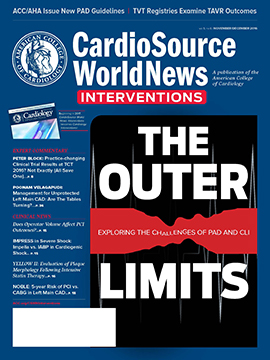Focus On: Quality Improvement | Methodist University Hospital A Pioneer in Process Improvement
CardioSource WorldNews Interventions | Recognizing a nationwide increase in the number of emergency department (ED) visits by patients with chest pain and the significant health care challenges posed by this trend, Methodist University Hospital (MUH) in Memphis, TN, launched a project to improve, optimize and stabilize the care of patients presenting to the ED with low and intermediate risk for Acute Coronary Syndrome (ACS). At the heart of the project: a process built around the concepts of Define, Measure, Analyze, Improve and Control (DMAIC).
The initial phase of the project was designed to enhance the management of ACS patients by improving the use of evidence-based guidelines in the evaluation and treatment of patients with chest pain from a baseline level of 56% to 75%. As a supplement to sound clinical judgement, a systematic approach to patient evaluation was developed using guidelines and appropriate use criteria (AUC) that enhanced electrocardiogram (ECG) interpretation, troponin evaluation methodology, risk stratification, and noninvasive testing. Implementation of this project required multiple changes in the patient evaluation and treatment pathway, which included:
- Developing and implementing a nurse/physician tool for use by a targeted team of physicians and nurses.
- Changing the ED physician role from all-inclusive responsibility to providing early triage of patients to an ACS evaluation pathway with early involvement of a consultant cardiologist. The cardiology responsibility was aligned with the existing ST-Elevation Myocardial Infarction (STEMI) Call Schedule to assure physician availability.
- Improving ECG interpretation to include specific criteria from the ACCF/AHA STEMI and Non- ST Elevation (NSTEMI)-ACS guidelines for diagnosis of ischemia with special consideration of other ECG changes.
- Making troponin interpretation consistent with the ACCF/AHA guidelines for acute myocardial necrosis with special considerations for trending or alternate etiologies as identified in the Third Universal Definition of Myocardial Infarction.
- Augmenting risk stratification with transition from exclusive use of the TIMI Risk Tool for NSTEM/UA to the addition of the Clinical Classification of Chest Pain to determine Pretest Probability of coronary artery disease (CAD) and Framingham Risk Score as a global risk tool.
- Adding the Canadian Cardiovascular (CCS) Grading System for Stable Angina as a gauge of symptom severity.
- Expanding noninvasive testing capability from pharmacological testing with nuclear imaging of all low/intermediate risk patients to inclusion of options for exercise treadmill, exercise treadmill with nuclear imaging, as well as exercise and pharmacological echocardiogram. An algorithm was developed using AUC for decision-making on the testing modality.
- Enhancing imaging interpretation of both ECHO and nuclear perfusion scans to reflect a risk score based on the percentage of affected myocardium.
- Using AUC as a guide for proceeding with heart catheterization.
Following implementation of these changes, MUH was able to achieve an aggregate score of 77.7% in the baseline-level use of evidence-based guidelines in the evaluation and treatment of patients with chest pain. This exceeded MUH’s Phase 1 goal and validated the hypothesis that a systematic approach would improve not only utilization of guideline-driven criteria, but the clinical effectiveness of the project as well. This success also resulted in MUH staff being recognized at the Society of Cardiovascular Patient Care’s Annual Conference with the first-ever “Process Improvement Pioneer Award.”
Looking ahead, MUH is currently in the midst of Phase 2 of its project, which is focused on providing care with an equitable use of health care resources. The goal is to improve clinical benefit, cost efficiency and cost effectiveness through the development of quality and performance goals for the ED, procedural areas and inpatient areas. The structure is designed to result in patient, financial and operational benefits through centralized care pathways that enhance throughput, align pathway utilization with medical necessity, and prevent unnecessary layered and downstream testing.
In addition to alignment of proper utilization of space and resources, the process will provide earlier intervention by clinical experts. An indirect benefit will be reduction in length of stay and readmissions for ACS patients. To assure the integrity of the project, authoritative oversight of this process will be provided by the Cardiovascular Executive Committee and Cardiovascular Patient Care Governance Committee. Corrective oversite, supported by administrative and educational resources, will provide monitoring and progress reports, thereby identifying opportunities for improvement.
*MUH is a tertiary hospital with a large service area that includes the Memphis metropolitan area as well as West Tennessee, East Arkansas and North Mississippi. It serves as a clinical teaching center for the University of Tennessee Health Science Center. MUH has a Cardiovascular Service Line that includes noninvasive cardiology, diagnostic and interventional cardiology, electrophysiology and cardiothoracic surgery. MUH is the flagship hospital of the Methodist Le Bonheur Healthcare system, which has been named the best hospital in Memphis by U.S. News and World Report for six consecutive years. MUH has been an accredited Chest Pain Center with Percutaneous Coronary Intervention (PCI) capability under the auspices of SCPC, the accreditation arm of the ACC, since 2008. It uses a model of care based on guidelines from the ACC/AHA and the SCPC Accreditation Tool.
Authors
Shadwan Alsafwah, MD, FACC, FCSAI
University of Tennessee Methodist Physicians
Marc Del Rosario, MD, FACC
Heart Center of Memphis
Uzoma Ibebuogu, MD, FACC, FSCAI
University of Tennessee Methodist Physicians
Rami Khouzam, MD, FACC, FACP, FASNC, FASE, FSCAI
University of Tennessee Methodist Physicians
Medical Director, Methodist University Hospital and
Program Director, Interventional Cardiology
University of Tennessee Health Science Center
Guy Reed, MS, MD
Professor Lemuel Diggs Professor of Medicine and
Chairman of the Department of Medicine
University of Tennessee Health Science Center
Bennett Rudorfer, MD, FACC
University of Tennessee Medical Group
Ray Walther, MD
Methodist University Hospital Emergency Department
Leesa Wright, RN CCRN, CCCC
Methodist University Hospital

|
Read the full November/December issue of CardioSource WorldNews Interventions at ACC.org/CSWNI |
Keywords: CardioSource WorldNews Interventions, Acute Coronary Syndrome, Electrocardiography, Emergency Service, Hospital, Hospitals, University, Troponin
< Back to Listings
